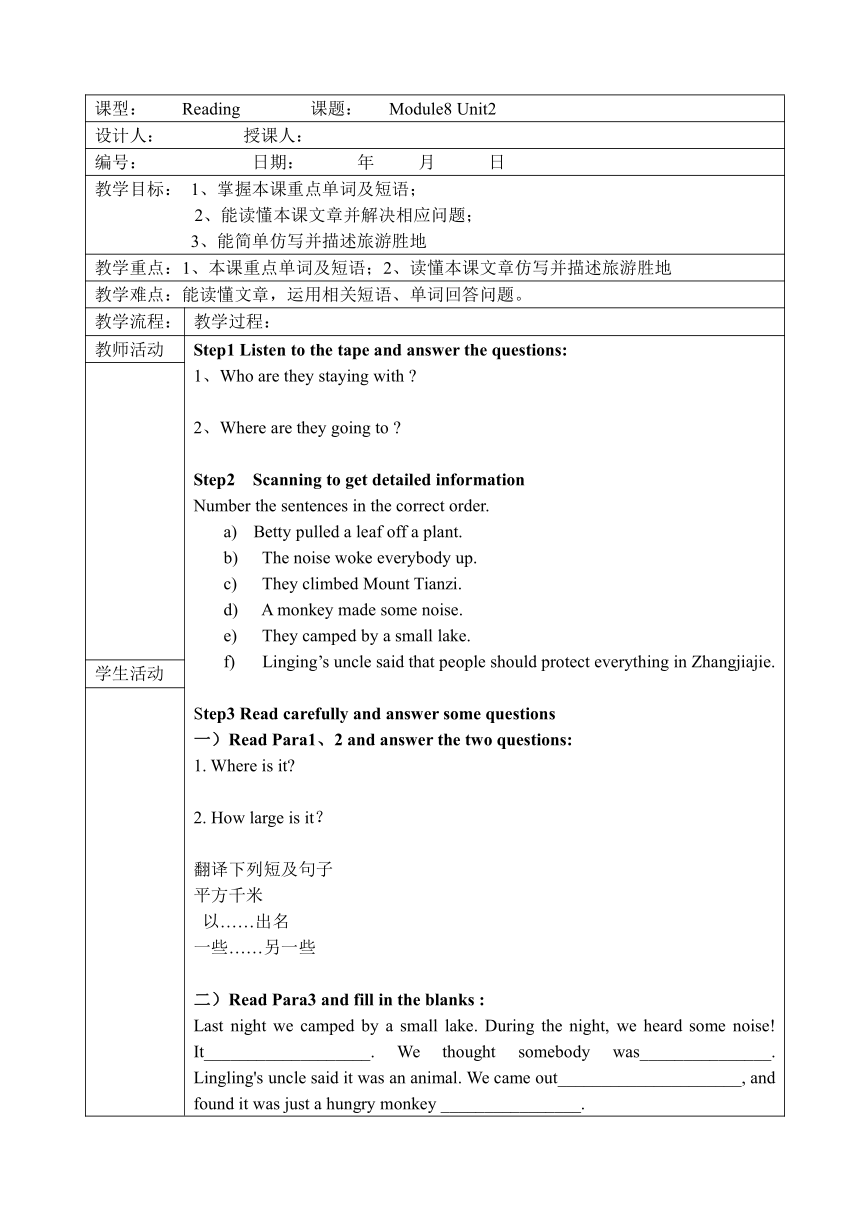外研版八下英语 Module 8 Unit 2 We thought somebody was moving about 导学案(无答案)
文档属性
| 名称 | 外研版八下英语 Module 8 Unit 2 We thought somebody was moving about 导学案(无答案) |  | |
| 格式 | zip | ||
| 文件大小 | 25.5KB | ||
| 资源类型 | 教案 | ||
| 版本资源 | 外研版 | ||
| 科目 | 英语 | ||
| 更新时间 | 2021-06-10 21:02:12 | ||
图片预览

文档简介
课型:
Reading
课题:
Module8
Unit2
设计人:
授课人:
编号:
日期:
年
月
日
教学目标:
1、掌握本课重点单词及短语;2、能读懂本课文章并解决相应问题;
3、能简单仿写并描述旅游胜地
教学重点:1、本课重点单词及短语;2、读懂本课文章仿写并描述旅游胜地
教学难点:能读懂文章,运用相关短语、单词回答问题。
教学流程:
教学过程:
教师活动
Step1
Listen
to
the
tape
and
answer
the
questions:1、Who
are
they
staying
with
?2、Where
are
they
going
to
?Step2
Scanning
to
get
detailed
informationNumber
the
sentences
in
the
correct
order.Betty
pulled
a
leaf
off
a
plant.
The
noise
woke
everybody
up.
They
climbed
Mount
Tianzi.
A
monkey
made
some
noise.
They
camped
by
a
small
lake.
Linging’s
uncle
said
that
people
should
protect
everything
in
Zhangjiajie.Step3
Read
carefully
and
answer
some
questions一)Read
Para1、2
and
answer
the
two
questions:1.
Where
is
it?2.
How
large
is
it?翻译下列短及句子平方千米
以……出名一些……另一些二)Read
Para3
and
fill
in
the
blanks
:Last
night
we
camped
by
a
small
lake.
During
the
night,
we
heard
some
noise!
It___________________.
We
thought
somebody
was_______________.
Lingling's
uncle
said
it
was
an
animal.
We
came
out_____________________,
and
found
it
was
just
a
hungry
monkey
________________.三)Read
Para4
根据短文内容,判断句子正误(T)误(F)
1、This
morning,
we
climbed
Mount
Tianzi!
(
)2、But
it
was
a
pity
that
it
was
sunny.
(
)3、Then
we
walked
down
the
river,
along
a
path,
past
trees
and
other
plants
and
back
to
the
camp.
(
)4、I
pulled
a
flower
off
a
plant.(
)5、
It
was
right
to
pull
leaves
off
plants
and
that
we
should
protect
everything
here.
(
)四)Read
the
last
Para
then
answer
the
questions:1、What
do
you
think
of
Dongting
Lake?2、When
will
they
back
home?Step4.Writing
(根据所给信息写一篇关于九寨沟的文章)Where
is
it
?Sichuan
ProvinceHow
large
is
it?about
62
square
kilometersWhat
can
you
see?Mountains,
rivers,
all
kinds
of
animals
and
plants,
forestsWhat
is
famous
for
waterfalls
(瀑布),streams(溪流),
Tibetan
village(藏族村)Where
can
you
sleep?Hotels
or
camps________________________________________________________________________________________________________________________________________________________________________________________________________________________________________________________________
学生活动
教学反思:
Reading
课题:
Module8
Unit2
设计人:
授课人:
编号:
日期:
年
月
日
教学目标:
1、掌握本课重点单词及短语;2、能读懂本课文章并解决相应问题;
3、能简单仿写并描述旅游胜地
教学重点:1、本课重点单词及短语;2、读懂本课文章仿写并描述旅游胜地
教学难点:能读懂文章,运用相关短语、单词回答问题。
教学流程:
教学过程:
教师活动
Step1
Listen
to
the
tape
and
answer
the
questions:1、Who
are
they
staying
with
?2、Where
are
they
going
to
?Step2
Scanning
to
get
detailed
informationNumber
the
sentences
in
the
correct
order.Betty
pulled
a
leaf
off
a
plant.
The
noise
woke
everybody
up.
They
climbed
Mount
Tianzi.
A
monkey
made
some
noise.
They
camped
by
a
small
lake.
Linging’s
uncle
said
that
people
should
protect
everything
in
Zhangjiajie.Step3
Read
carefully
and
answer
some
questions一)Read
Para1、2
and
answer
the
two
questions:1.
Where
is
it?2.
How
large
is
it?翻译下列短及句子平方千米
以……出名一些……另一些二)Read
Para3
and
fill
in
the
blanks
:Last
night
we
camped
by
a
small
lake.
During
the
night,
we
heard
some
noise!
It___________________.
We
thought
somebody
was_______________.
Lingling's
uncle
said
it
was
an
animal.
We
came
out_____________________,
and
found
it
was
just
a
hungry
monkey
________________.三)Read
Para4
根据短文内容,判断句子正误(T)误(F)
1、This
morning,
we
climbed
Mount
Tianzi!
(
)2、But
it
was
a
pity
that
it
was
sunny.
(
)3、Then
we
walked
down
the
river,
along
a
path,
past
trees
and
other
plants
and
back
to
the
camp.
(
)4、I
pulled
a
flower
off
a
plant.(
)5、
It
was
right
to
pull
leaves
off
plants
and
that
we
should
protect
everything
here.
(
)四)Read
the
last
Para
then
answer
the
questions:1、What
do
you
think
of
Dongting
Lake?2、When
will
they
back
home?Step4.Writing
(根据所给信息写一篇关于九寨沟的文章)Where
is
it
?Sichuan
ProvinceHow
large
is
it?about
62
square
kilometersWhat
can
you
see?Mountains,
rivers,
all
kinds
of
animals
and
plants,
forestsWhat
is
famous
for
waterfalls
(瀑布),streams(溪流),
Tibetan
village(藏族村)Where
can
you
sleep?Hotels
or
camps________________________________________________________________________________________________________________________________________________________________________________________________________________________________________________________________
学生活动
教学反思:
同课章节目录
- Module 1 Feelings and impressions
- Unit 1 It smells delicious.
- Unit 2 I feel nervous when I speak Chinese .
- Unit 3 Language in use
- Module 2 Experiences
- Unit 1 I've also entered lots of speaking competi
- Unit 2 They have seen the Pyramids.
- Unit 3 Language in use
- Module 3 Journey to space
- Unit 1 Has it arrived yet?
- Unit 2 We have not found life on any other planet
- Unit 3 Language in use
- Module 4 Seeing the docto
- Unit 1 I haven't done much exercise since I got m
- Unit 2 We have played football for a year now
- Unit 3 Language in use
- Module 5 Cartoons
- Unit 1 It's time to watch a cartoon.
- Unit 2 Tintin has been popular for over eighty yea
- Unit 3 Language in use
- Revision module A
- Module 6 Hobbies
- Unit 1 Do you collect anything ?
- Unit 2 Hobbies can make you grow as a person.
- Unit 3 Language in use
- Module 7 Summer in Los Angeles
- Unit 1 Please write to me and send me some photos
- Unit 2 Fill out a form and come to learn English
- Unit 3 Language in use
- Module 8 Time off
- Unit 1 I can hardly believe we are in the city ce
- Unit 2 We thought somebody was moving about
- Unit 3 Language in use
- Module 9 Friendship
- Unit 1 Could I ask if you've mentioned this to he
- Unit 2 I believe that the world is what you think
- Unit 3 Language in use
- Module 10 On the radio
- Unit 1 I hope that you can join us one day
- Unit 2 It seemed that they were speaking to me in
- Unit 3 Language in use
- Revision module B
